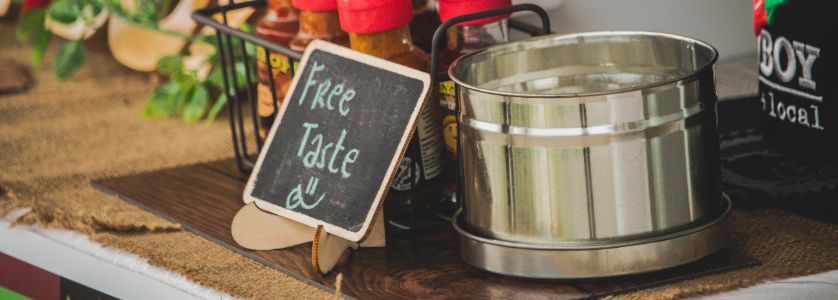Product sampling has always been a reliable way to showcase and promote products. Traditionally, in-store sampling has been the norm, where customers can interact with products directly. However, with the rise of digital platforms and subscription boxes, we now have indirect sampling making its way into the virtual realm.
What is the most effective sampling method for your business? Let's explore the benefits and challenges of both approaches to see which one wins out.
Let's walk through these different types of sampling in more detail to help you figure out which one is right for you.
In-Store Sampling
In-store sampling, also known as direct sampling, involves offering product samples directly to customers in a physical environment. This marketing tactic is commonly used in grocery stores or trade shows.
Benefits of In-Store Sampling:
- Tangible Experience: In-store product sampling allows customers to physically interact with the product, which can create a more memorable and impactful experience.
- Immediate Feedback: Companies can gather real-time feedback from customers, helping them understand consumer preferences and make necessary adjustments.
- Targeted Approach: In-store sampling allows companies to specifically target customers who are already present in the store, increasing the likelihood of reaching their target audience.
Challenges of In-Store Sampling:
- Time Constraints: In store sampling may only provide a brief interaction with the product, limiting the information customers can gather.
- Cost and Logistics: Setting up in-store product sampling can be expensive and requires coordination with retail partners, making it more challenging to execute on a large scale. Additionally, bigger retailers tend to bundle this with other commitments, which can further complicate efforts, particularly when the primary goal is to encourage product trials.
- Limited Reach: In-store sampling is restricted to customers who visit physical retail locations, potentially missing out on a wider audience.
Indirect Sampling
Indirect sampling, also known as virtual sampling or ecommerce sampling, involves providing product samples to customers through online platforms or other indirect means. In this method, customers can order samples through websites, online platforms, or receive product samples as a bonus with their ecommerce order or subscription box.
Benefits of Indirect Sampling:
- Wide Reach: Indirect sampling allows companies to reach a larger audience, including customers who prefer online shopping or are located in different geographic areas.
- Convenience: Customers can conveniently access and try product samples from the comfort of their own homes or through virtual platforms. For example, with HelloFresh Group, our partnership opportunities give brands the ability to reach families at key moments in their day – dinner time.
- Cost-Effective: Indirect sampling can be more cost-effective than in-store sampling, as it eliminates the need for physical setup and reduces logistical expenses.
Challenges of Indirect Sampling:
- Limited Feedback Loop: Even though you can gather customer feedback with indirect sampling, in-store reps often have the advantage of conducting deeper interviews due to face-to-face customer interaction.
- Delayed Conversion Rates: Without the immediate in-store experience, customers may take longer to make purchase decisions.
When to Use Indirect Sampling vs Direct Sampling?
The choice between in-store sampling and indirect sampling depends on various factors, including the target audience, product type, and marketing goals. Consider the following factors:
Use in-store sampling when:
- Targeting a specific demographic that frequently visits physical retail locations.
- Seeking to create a memorable and interactive experience.
Use indirect sampling when:
- Targeting a wider audience that includes online shoppers and customers from different locations.
- Looking for a cost-effective way to distribute product samples.
- Allowing customers to try the product at their convenience.
By understanding the differences between in-store sampling and indirect sampling, companies can make informed decisions to drive product awareness effectively.
If you are interested in product sampling, please connect with us. We have a lot of different options to help promote your brand.





